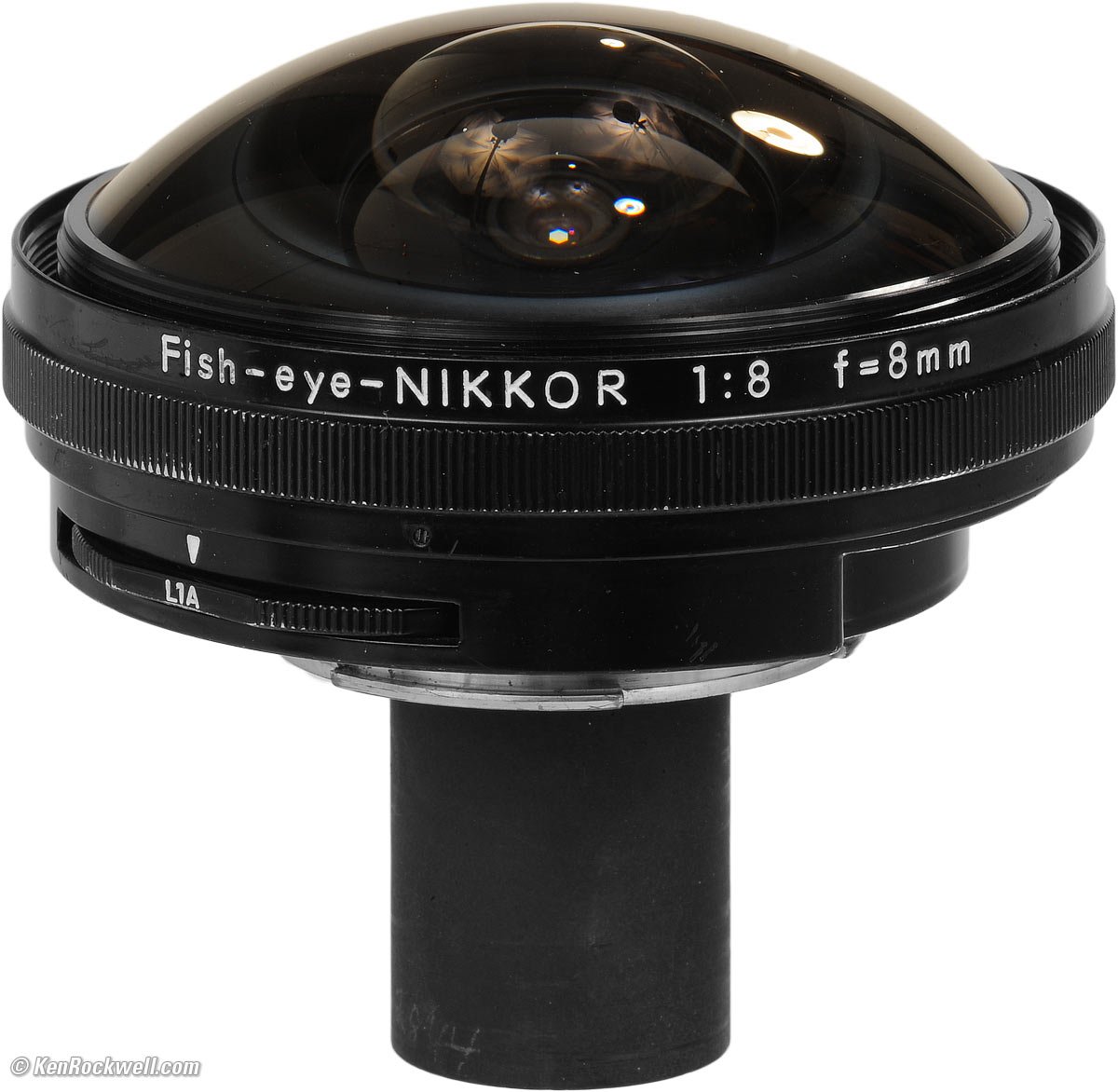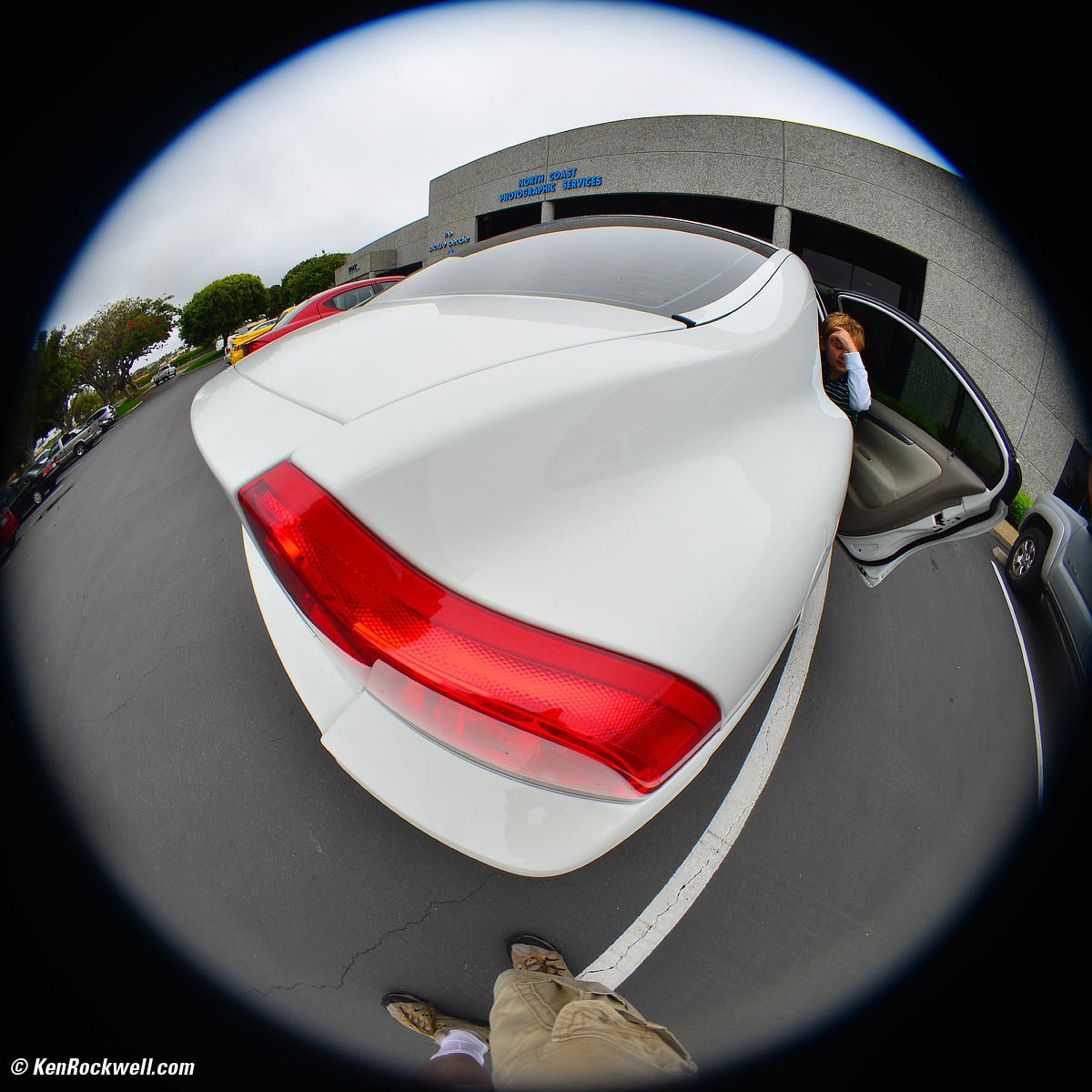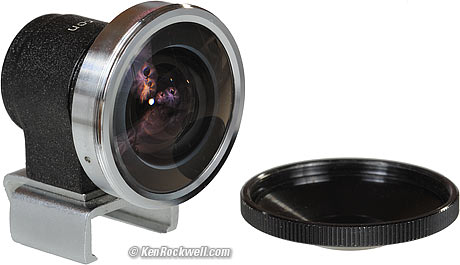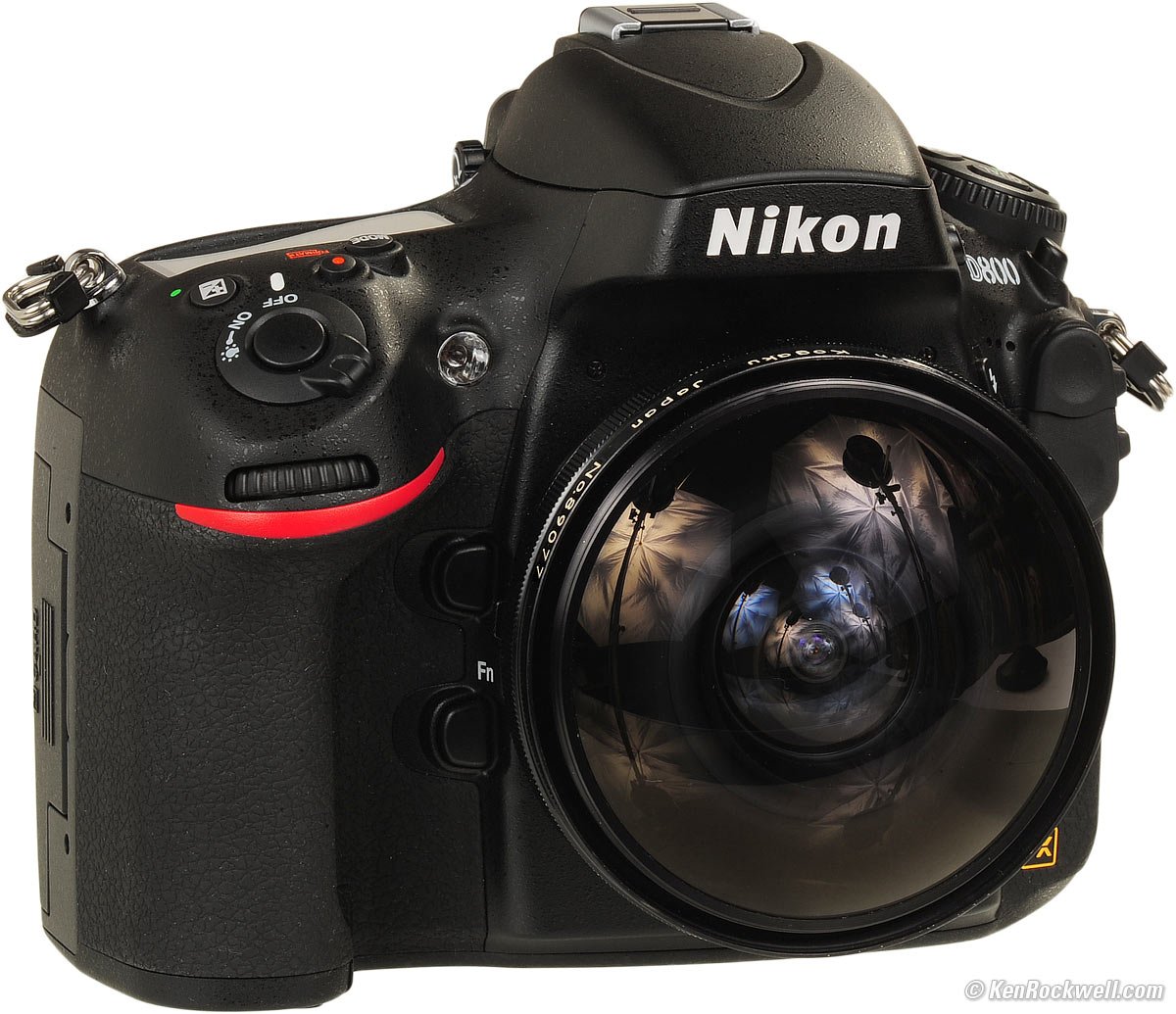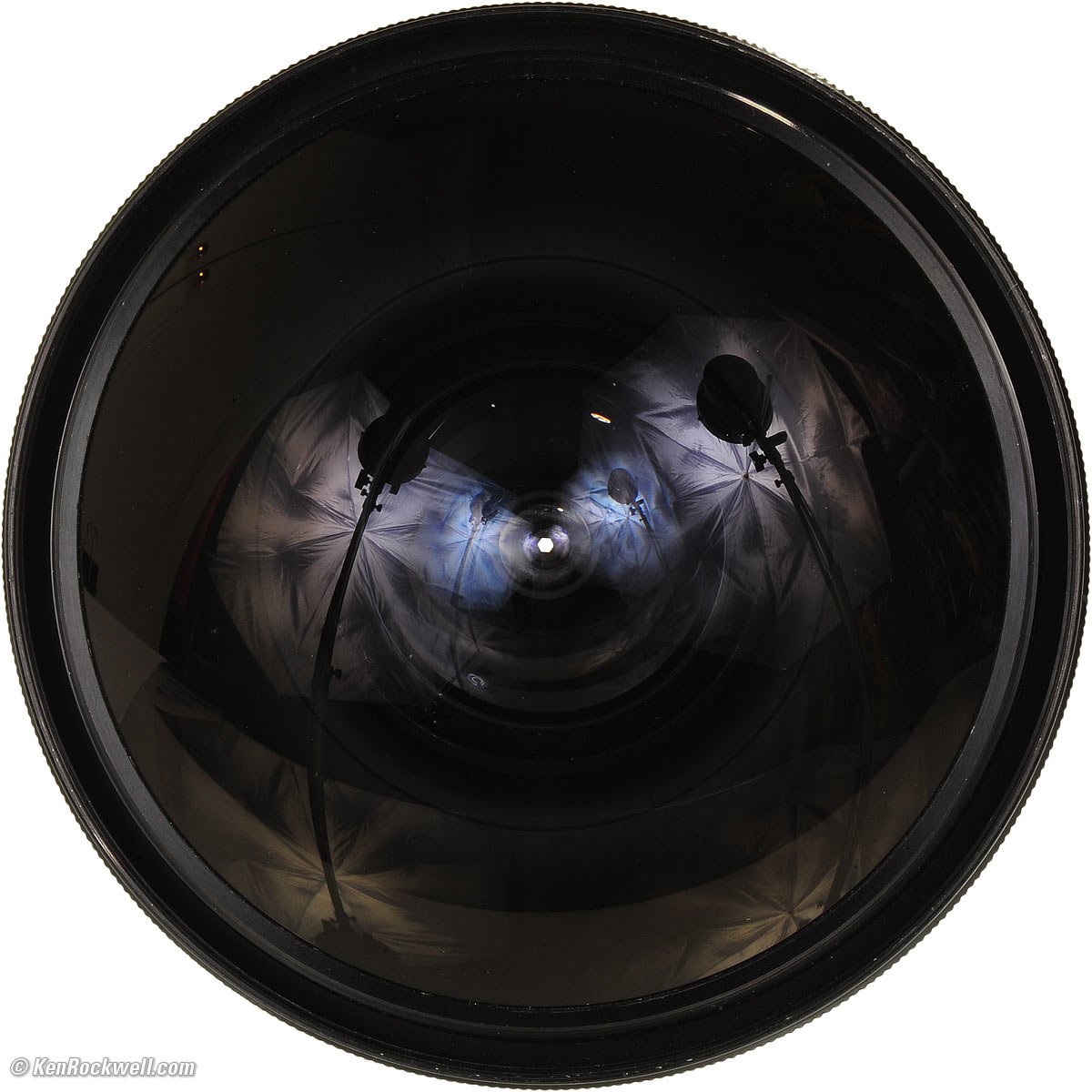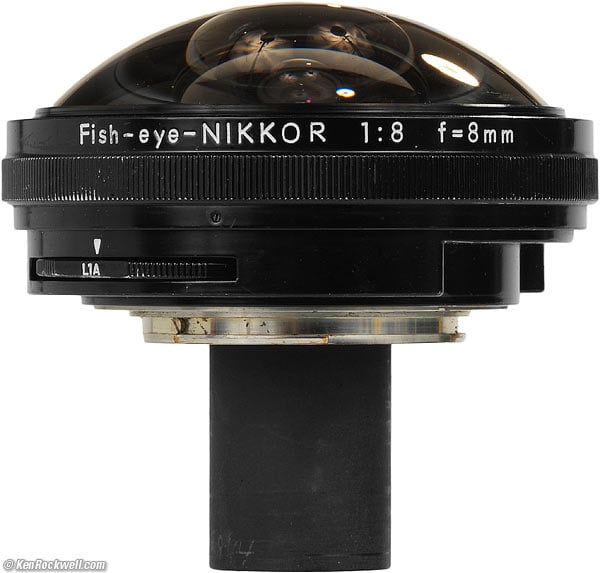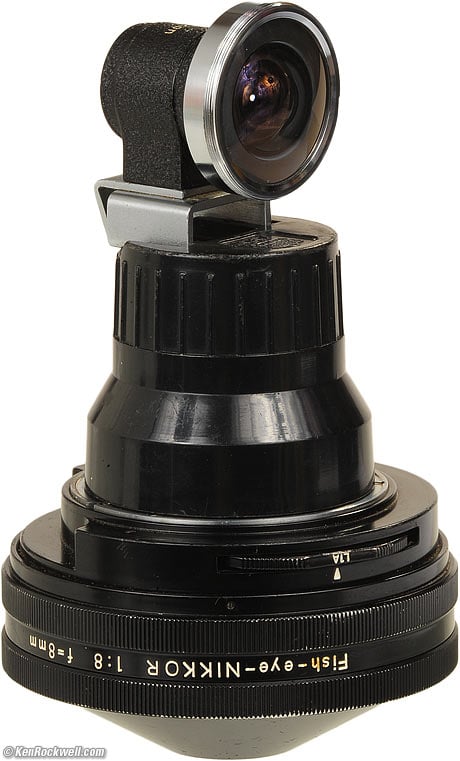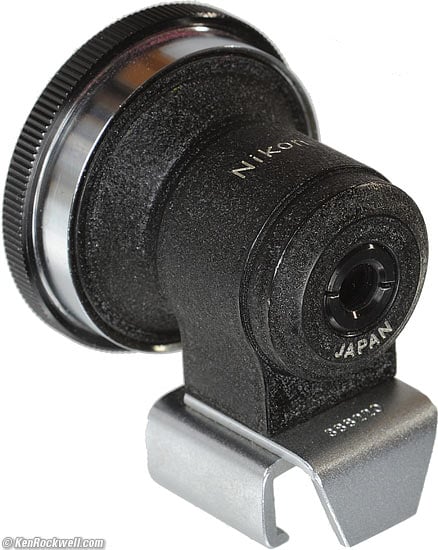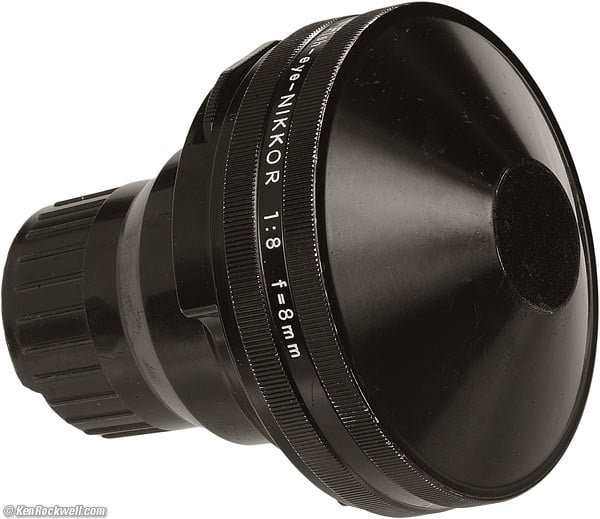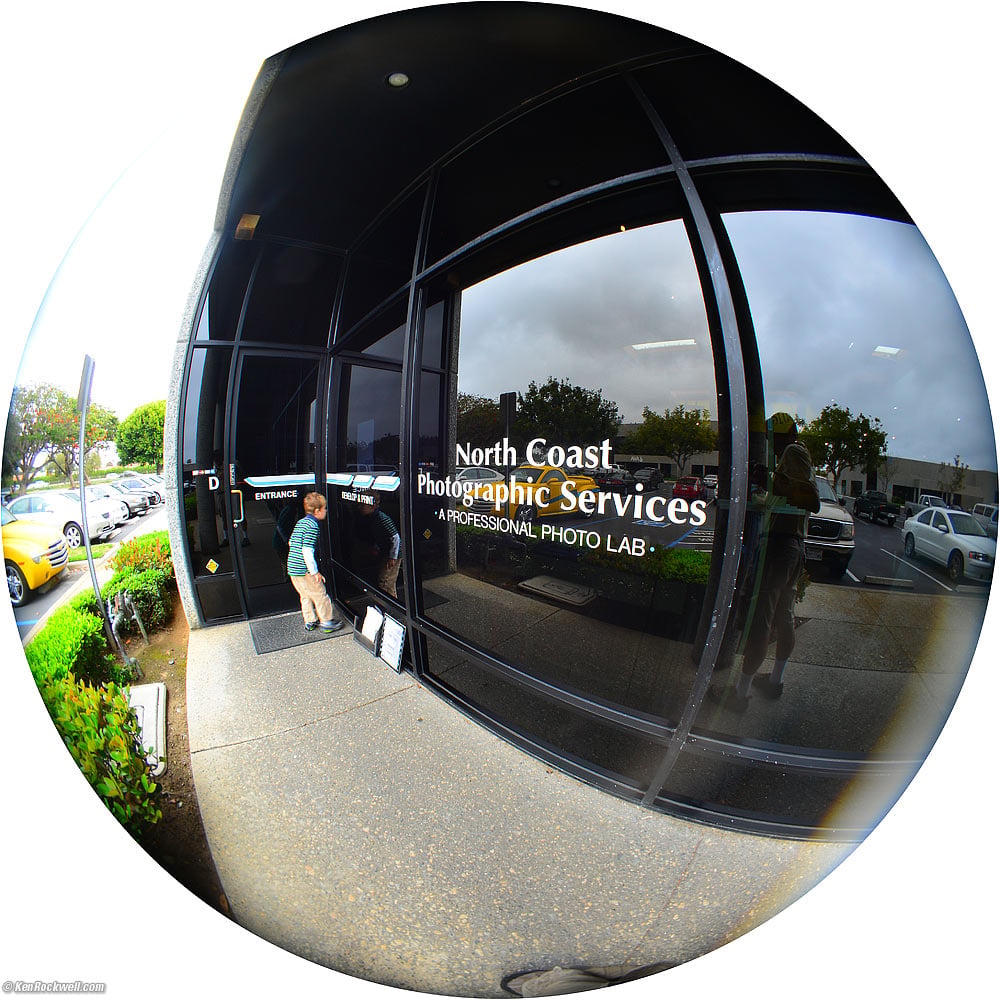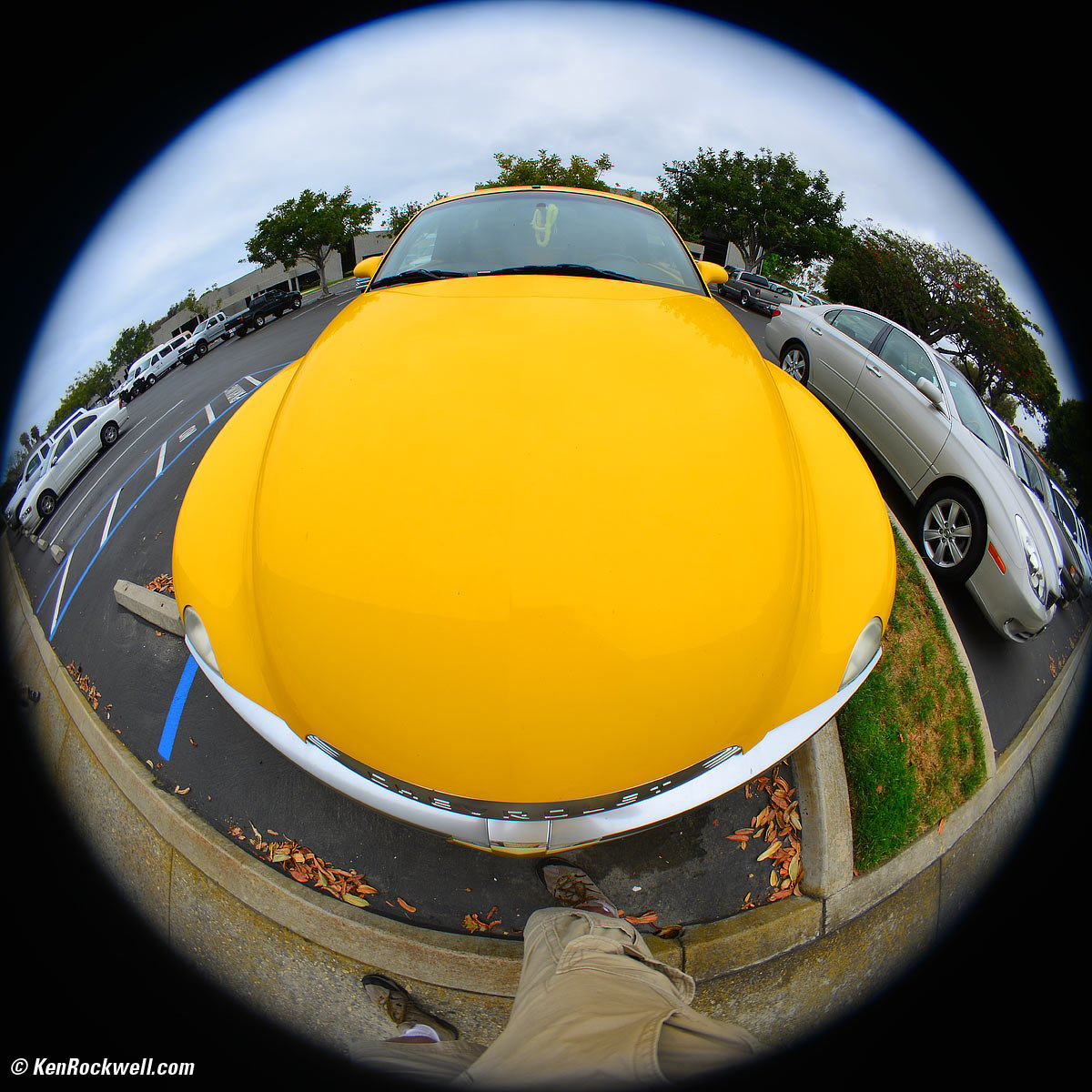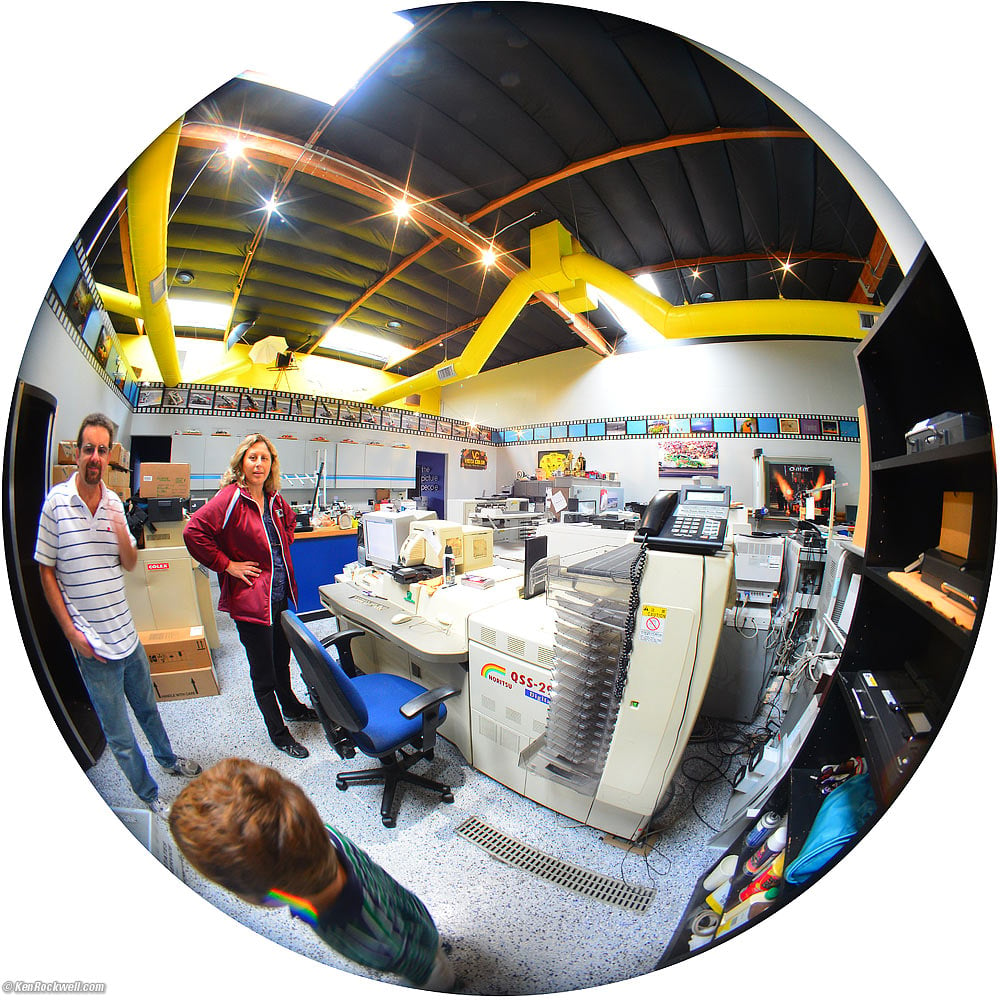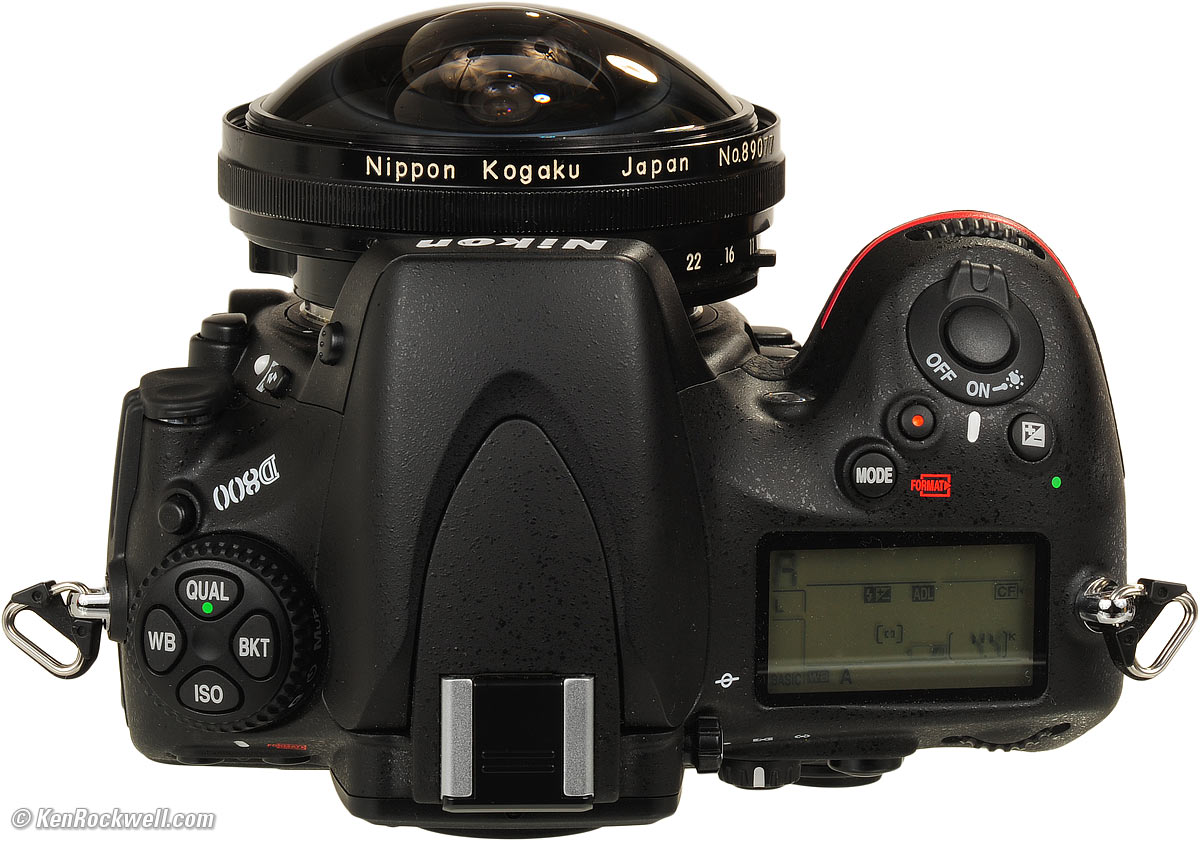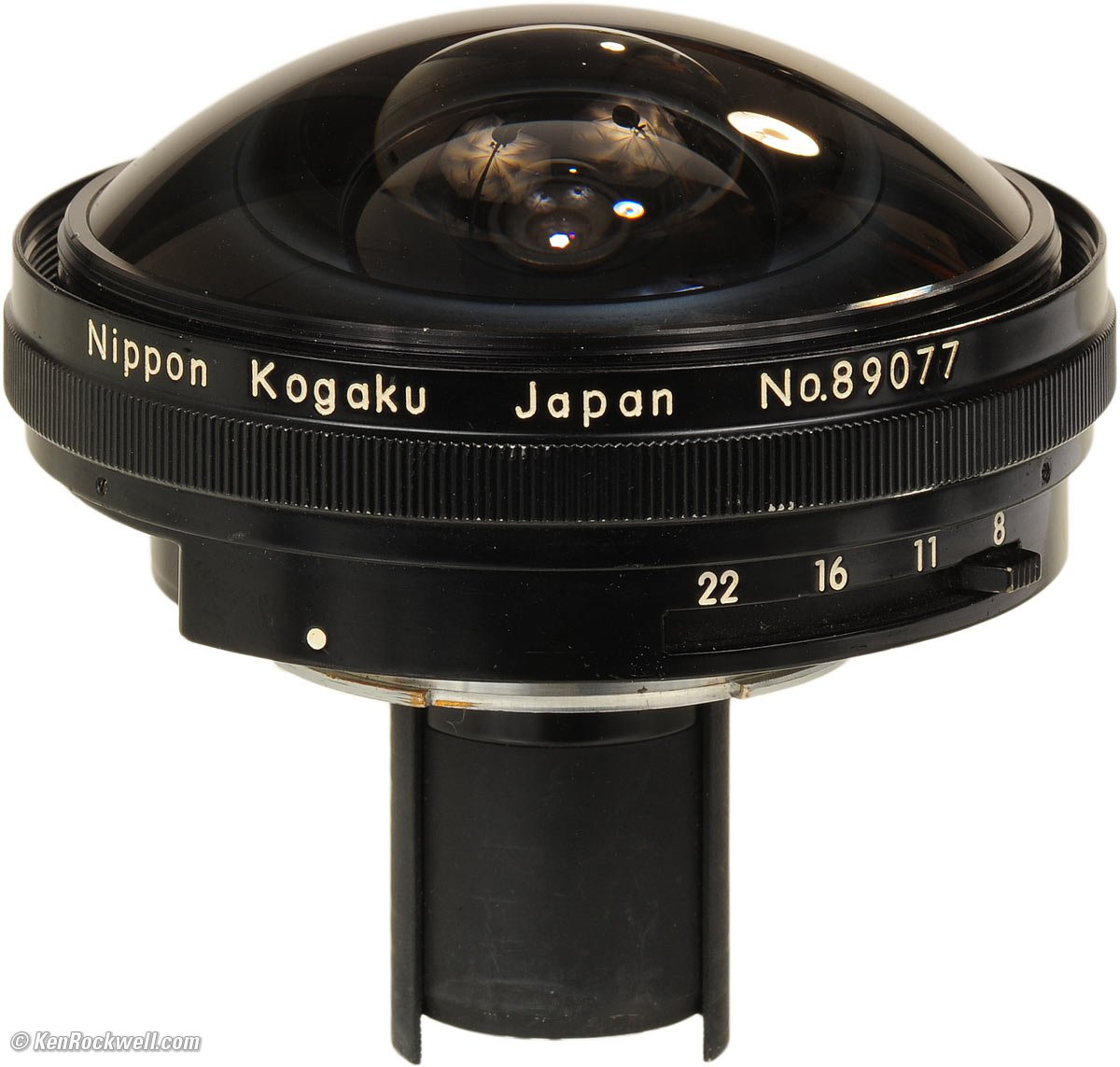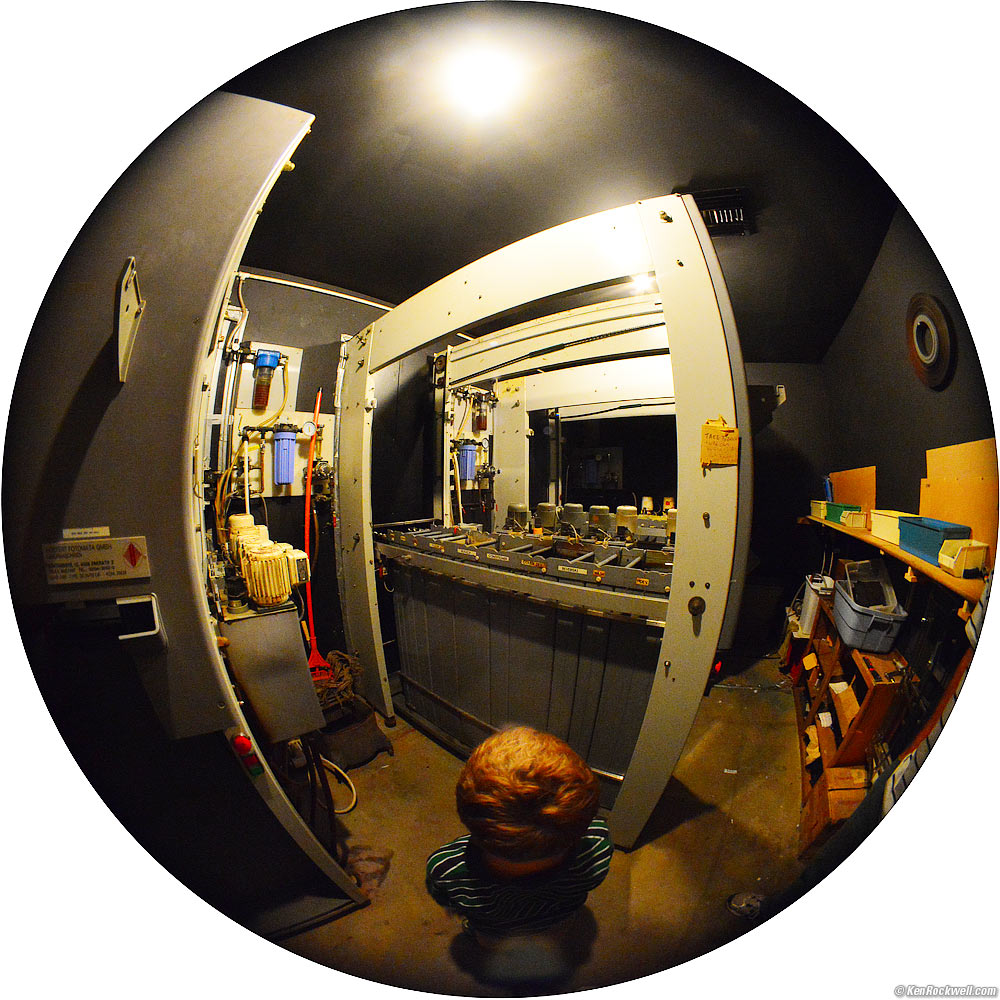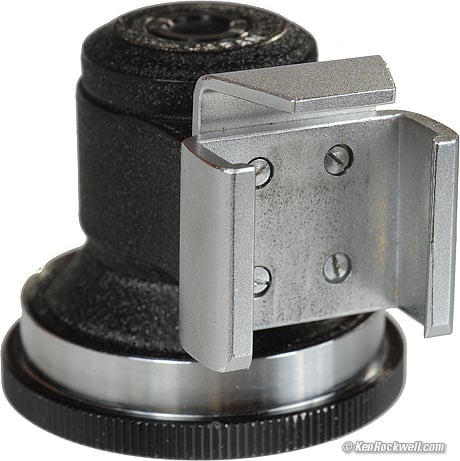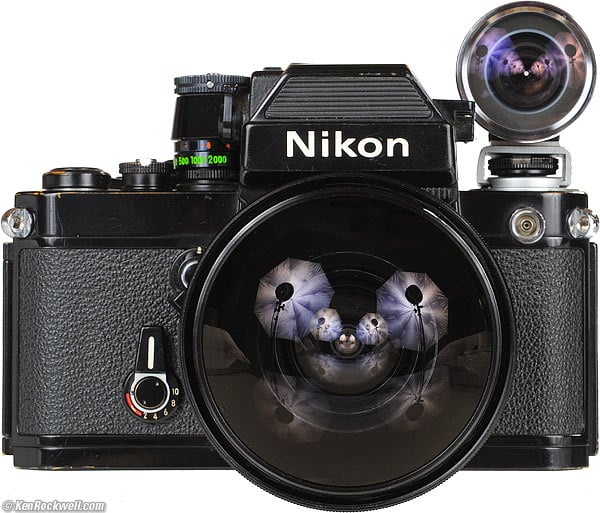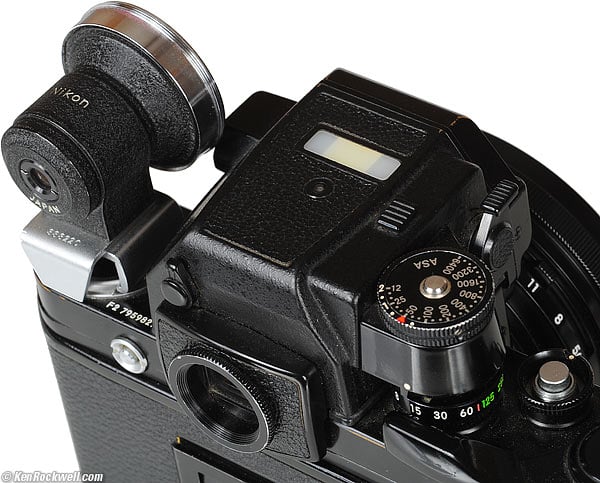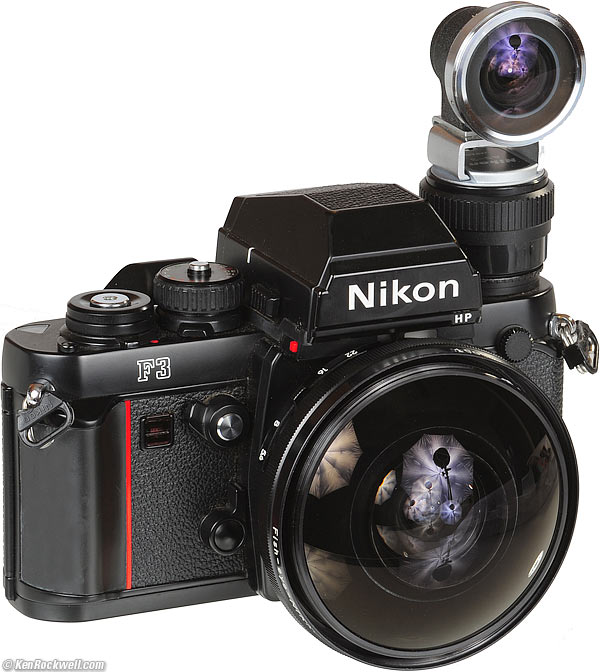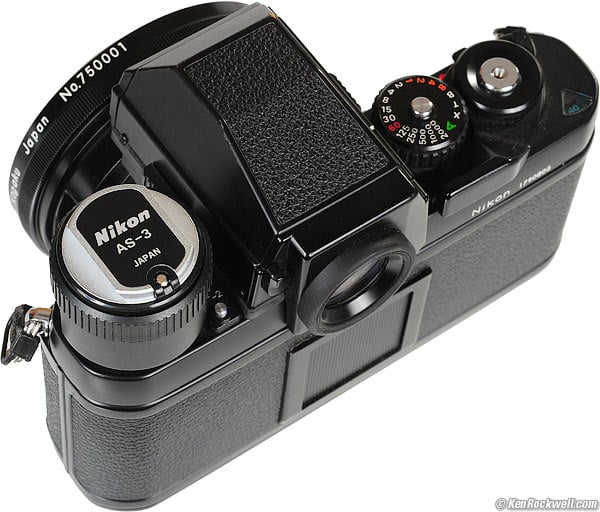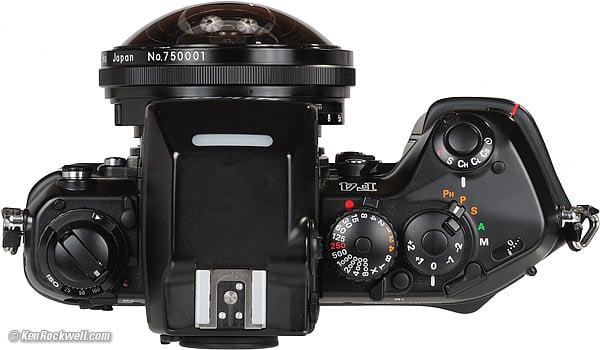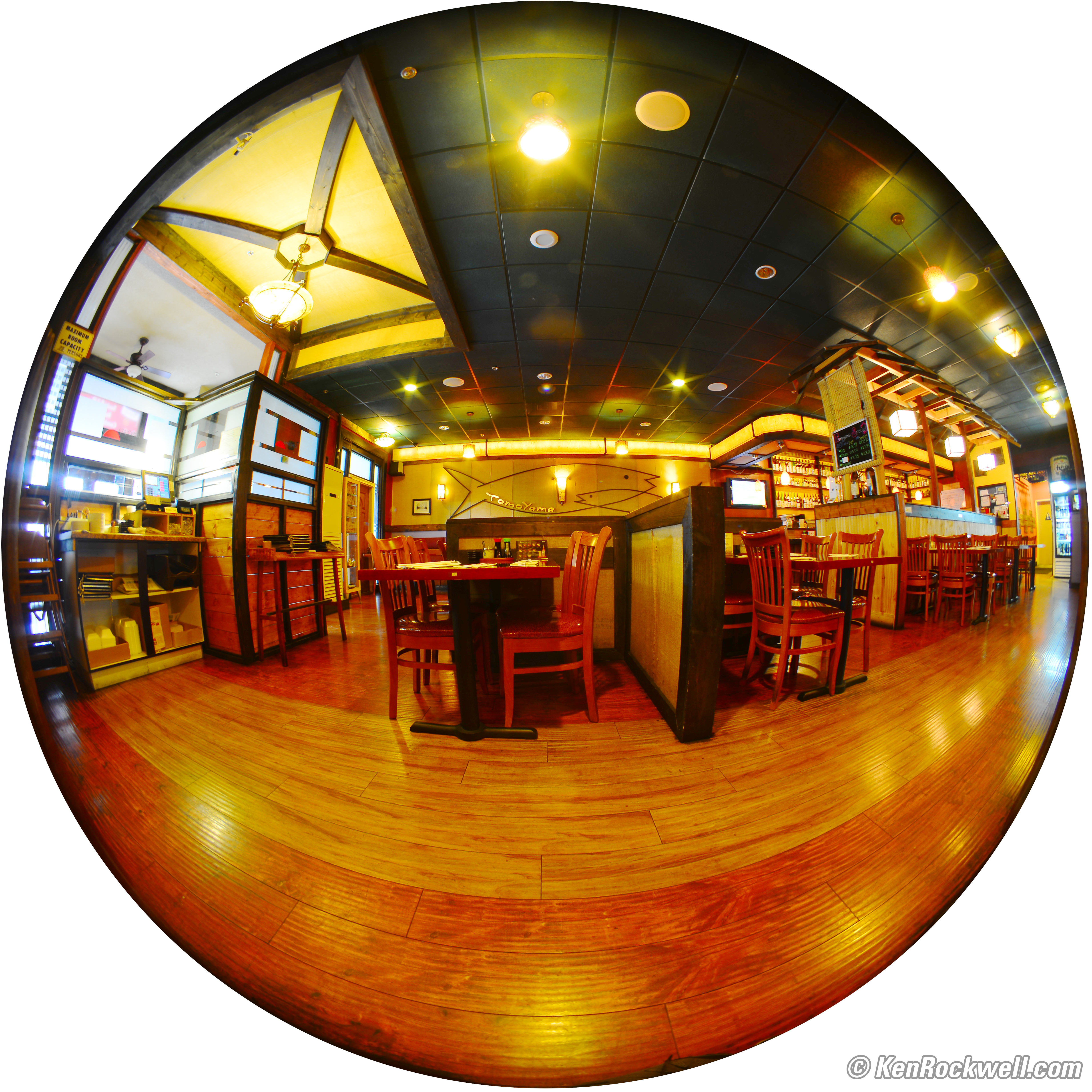Nikon 8mm f/8
Fish-Eye-NIKKOR (1962-1965)
Intro Specs Performance Usage Recommendations
Nikon 8mm f/8 Fisheye (built-in filters, 10.4 oz./295g, maybe about $500 used if it has all the parts.). enlarge. The back of the lens pokes way back from the chrome mount.
This free website's biggest source of support is when you use these links, especially this link directly to them at eBay (see How to Win at eBay) when you get anything, regardless of the country in which you live. Thanks! Ken.
May 2012 More Nikon Reviews Nikon Lenses All Reviews
How To Use Ultrawide Lenses: Get Close!
7.5mm f/5.6 (1966-1970)
8mm f/2.8 (1970-1997)
10.5mm DX (2004-today)
16mm f/3.5 (1973-1979)
16mm f/2.8 (1979-1998)
16mm f/2.8 AF-D (1993-today)
Pro-Optic 8mm f/3.5 (2009-)
Introduction top
Intro Specs Performance Usage Recommendations
|
I buy only from these approved sources. I can't vouch for ads below. |
This 8mm f/8 is Nikon's earliest 35mm-format 180-degree circular fisheye lens. The sample reviewed here in 2012 was made in 1964.
Its image is a 24mm-diameter circle filling the middle of the FX frame, surrounded by black:
Image on FX. (f/8 at 1/125, D800 at ISO 100. Ryan in car, Dada's legs at bottom, about 2" from car.) bigger (cropped to square).
This 24mm diameter image circle is the largest of any Nikon circular fisheye. As you see above, since 24mm is the nominal maximum vertical size of the film or sensor, you often lost the top or bottom edge, so newer models reduced this to 23mm.
Used on DX, the image reaches from left to right along the center line, but with black triangles in each corner and the top and bottom of the circle cut off.
This 8mm's primitive design pokes deeply into your camera, so it requires locking-up the mirror to mount it. If you don't lock-up your camera's mirror, you'll smash it attempting to mount this lens.
Focus is easy: since everything is always in focus with an 8mm lens at f/8, focus is fixed. This is much easier to use than the 8mm f/2.8 which adds the annoyance of a focus control which gets knocked off-focus more often than you'd think. Even wide-open at f/8, this small 8mm fisheye is always in focus from a few inches to infinity.
With Live View DSLRs — and if you're not afraid of lifting your DSLR's mirror with your dirty little fingers while trying to attach this thing — it works far better on today's DSLRs than it ever did when new!
It was, and still is, a royal pain to use on the 35mm cameras for which it was designed.
Without Live View, you can't look through any camera to see what you're photographing. You have to use a special finder that comes with the lens and slip it on the weird accessory shoe of your Nikon F or F2. The finder does not slip into a standard hot shoe, or mount directly on any other Nikons!
160 degree viewfinder and its own screw-in midget cap.
The finder isn't needed or wanted with Live View. The finder, if you use it with a 35mm camera, is very sharp.
This 8mm is more of collectors' item today, since you can buy a brand-new Pro-Optic 8mm f/3.5 for less money, which is far easier to use and which has far better optical performance. The Pro-Optic 8mm f/3.5 is designed for DX cameras; it's not a circular FX fisheye as is this 8mm f/8.
Compatibility top
Even as a collectors' item, Nikon hasn't forgotten it. It's mentioned on page 374 of my D800 USA user's manual. Sadly the mention is on the list of incompatible lenses!
This is one of the very few Nikon lenses which simply won't work properly on any digital camera unless you rig up some sort of complex optical relay system beyond the scope of this website — or if you dare pull-up the mirror with your finger and jam in the lens. Do this, use Live View, and you're good to go!
If you follow Nikon's directions, it only works properly on cameras which allow full-time mirror lockup, which means the F, F2, F3, F4, F5 and some of the earliest pre-AI amateur Nikons, like the Nikkormat FT, from the early 1970s.
With the Nikon F, you need to remove any Photomic finder since it will interfere. Likewise with the Nikon F, locking up the mirror is a multi-step affair requiring you to waste a frame of film.
If you're queasy about trying to hold-up your mirror as you attempt to jam this lens on your camera (DSLR mirrors aren't just a mirror; they are a complex network of many mirrors moving in every direction), you might also want to try the "Mirror Lock-Up for Cleaning" menu option.
Much more at Usage.
History top
1962-1965
This 8mm f/8 was Nikon's first 35mm-format fisheye, with a 24mm diameter image circle.
The 24mm image circle was a great idea for science, but a bad idea for photography because slide mounts and enlarger film holders cut off the tops and bottoms of the circles.
Nikon made about 1,500 of these.
1966-1970
The 7.5mm fisheye replaced this 8mm, with a smaller 23mm diameter image circle.
It's a stop faster, and has a slightly smaller 23mm image circle that fits more slide mounts and negative holders.
Nikon made about 2,500 of these.
1970-1997
The huge 8mm f/2.8 reflex lens replaced the mirror-up 7.5mm, both of which have a 23mm diameter image circle.
The huge f/2.8 lens meters, composes and shoots without having to move any mirrors, but is 5" (125mm) in diameter and weighs over two pounds (1kg)!
Nikon made close to 10,000 of these.
1998-present
Nikon has not made any circular fisheyes since 1997; the world has enough to go around.
Nikon has also made 220 degree 6mm fisheyes, 10mm orthographic projection and other fisheyes I won't cover here — yet.
Nikon 8mm mounted on a D800. enlarge.
Specifications top
Intro Specs Performance Usage Recommendations
Name
Nikon calls this the Nippon Kogaku Fish-eye-NIKKOR 8mm f/8.
Optics
9 elements in 5 groups. (The newer 7.5mm is 9 elements in 6 groups.)
One additional flat filter ahead of the diaphragm.
Spherical design, single-coated.
Image Circle Diameter: 24mm.
Focus
Fixed.
Everything is always in focus from a foot away at f/8 or a few inches at smaller apertures.
Diaphragm
Nikon 8mm f/8 fisheye at f/8. bigger.
6 straight blades.
Manual.
Stops down to f/22 with clicks at full stops.
All intermediate settings work.
If you look closely, even at f/8, the diaphragm isn't anywhere near completely open. It appears that the optics might actually be f/4 or faster — but don't dare screw with it.
Filters
Nikon 8mm f/8, note filter wheel on left.
Internal turret with 6 filters: L1A skylight, Y48 and Y51 yellow, O57 orange, R60 red and X0 light green.
The earliest models (about the first hundred made in 1962) used a slightly different set of L38 (UV), Y48, Y52, O56, R60 and X0 filters.
To change filters, simply move the control which rotates the internal turret.
Filter Factors
Daylight Filter Factor, Stops (time) |
Tungsten Filter Factor, Stops (time) |
Film Type |
||
L1A |
Skylight |
0 (1x) |
0 (1x) |
Color and B/W |
Y48 |
Medium Yellow |
2/3 (1.7x) |
1/4 (1.2x) |
B/W |
Y52 |
Deep Yellow |
1 (2x) |
1/2 (1.4x) |
B/W |
O57 |
Orange |
1-3/4 (3.5x) |
1 (2x) |
B/W |
R60 |
Red |
2-2/3 (6x) |
2-1/3 (5x) |
B/W |
X0 |
Light Green |
1 (2x) |
2/3 (1.7x) |
B/W |
Size
Nikon specifies 3.23" (82mm) diameter by 1.67" (42.3mm) projection from flange (77mm total).
(Nikon specifies the 7.5mm lens as 3-7/32" (82mm) diameter by 3-5/32" (80mm) long overall in its printed manual, for comparison.)
Weight
10.415 oz. (295.3g).
12.090 oz. (342.8g), with caps.
Finder 2.370 oz. (67.2g), without caps.
Nikon specifies 300g (350g for the 7.5mm lens for comparison).
Hood
None, silly.
Caps
Nikon 8mm f/8 fisheye with some of its special caps.
The finder front cap (shown at top) is anodized spun-aluminum.
The finder has no rear cap.
The finder slips into grooves in the plastic rear cap to keep this all together.
The plastic rear cap is very deep to accommodate the protruding rear elements. This weird cap also attaches to any other Nikon SLR lens as you swap lenses.
Nikon 8mm with front and rear caps.
While the front caps of the newer 7.5mm and 8mm f/2.8 have rubber safety bumpers on the back of the cap, this cap has none. Be careful not to damage the front element when removing and attaching the cap.
This sold with the 8mm lens, 160 degree viewfinder, specialized front and specialized rear caps for the lens, specialized front cap for the finder, Corinthian leather case and instruction manual.
If you're missing anything, God help you trying to find it.
Performance top
Intro Specs Performance Usage Recommendations
Overall Focus Ergonomics Projection Falloff
Ghosts Color Fringes Mechanics Sharpness Sunstars
Overall performance top
Ryan dropping film at North Coast Photographic Services, 29 April 2012. (Nikon D800, 1/30 at f/8 at ISO 250). bigger.
This 8mm lens works great, but it's hard to find and priced for collectors.
Today, the new Pro-Optic 8mm f/3.5 costs much less and works much better.
If you come across one and use Live View, it's very handy.
Focusing performance top
Focus is fixed (pan focus).
Depth of field is so all-encompassing that focus is fixed at about 3.3 feet (1 meter) and everything is in focus. If you see my "Perfect Sharpness" article you'll see that a 8mm lens at f/8 really can get everything in optimum focus from 1 foot (0.3m) to infinity.
Ergonomics performance top
You have to be very careful of the bulbous front element. I'm always attaching and removing the cap only to shoot.
Otherwise, presuming the Usage requirements don't scare you, there's nothing else to set. I leave mine at f/8 and just shoot; it's always in focus.
Projection performance top
This 8mm f/8 Fish-eye has less distortion than newer fisheyes. In the case of a fisheye, this means less deviation from the formal r = fθ equidistant (equal-angle) projection.
As intended for scientific use, the distance of an object from the center of the image is quite linearly related to its angle away from the center.
In English, this means that objects are less compressed towards the sides than with current fisheye lenses. Objects are about the same size anywhere in the image, which I prefer.
While it's not a perfect r = fθ projection, it's far more linear than any current fisheye. or the huge 8mm f/2.8. When compared to the newer 8mm f/2.8, subjects along the sides are much less squished.
See the Projection of the 7.5mm f/5.6 Fisheye for more data, which might actually be the data for this lens.
Falloff (darkened edges) performance top
Yellow SSR from a few inches, and my shorts and shoes. (f/8 at 1/125, cropped to square from D800 at ISO 100.) bigger.
While there isn't any falloff, the edges do fade to black more softly than they do with the 8mm f/2.8, whose edges cut to black sharply.
I'd rather have the edges sharp today, since I always can fade them later, but if I want a fade-to-white for online use, it's much tougher with the softer edges of this 8mm lens' images.
Ghosts performance top
It usually has a few dots from the sun someplace, and these dots are usually hexagons.
Lateral Color Fringes performance top
Shot on the D800, this original 8mm has lateral (side) color fringes.
They vary from none in the center to red/cyan about halfway out, to blue/yellow towards to the edges.
Full-resolution sample image from D800.
Mechanics performance top
Rear, Nikon 8mm f/8. enlarge.
Everything
Metal.
Barrel
Enameled and anodized aluminum.
Front Cap
Enameled anodized metal.
Mount
Dull-chromed brass.
Markings
Engraved and filled with paint.
Serial Number
Engraved and filled with paint on the main identity ring. Nikon was paying attention, and started the serial numbers for this 8mm f/8 lens at 88,000.
Finder
All metal, black crinkle finish, engraved markings (not filled with paint; engravings show bare aluminum underneath), serial number stamped on top of chromed brass foot.
Sharpness performance top
This 8mm f/8 fisheye is super-sharp in the center, even on a 36 MP D800, but not as sharp as the more modern 8mm f/2.8 or Pro-Optic 8mm f/3.5 on the sides.
Few people care; this is a lens for special effects, not mural-sized straight, perspective-corrected prints.
Sunstars performance top
With a very-straight-sided 6-blade diaphragm, it easily makes sharp 6-pointed sunstars on bright points of light.
Ryan checking out the processors at North Coast Photographic Services. (Nikon D800, 1/8 at f/8 at AUTO ISO 1,000.) full-resolution.
Usage top
Intro Specs Performance Usage Recommendations
Since this 8mm pokes into your camera, you must remember to lock up your mirror before jamming it on, otherwise you'll smash your SLR's mirror.
Nikon and I both suggest keeping the front cap on all all times, except to shoot. It's easy to destroy the lens walking around since it pokes out like a fish bowl.
Everything is always in focus; there is no focus adjustment.
This is great, but also means that any dirt or dust on the front element (or internal fungus) will be seen in your image, especially at smaller apertures.
Nikon's manual suggests waving a 3" diameter plate on the end of a coat hanger in front of the lens to shield the disc of the sun.
Watch your fingers on your grip. You'll usually see them on the right side of the image if you're not very careful to keep them hidden.
Nikon 8mm mounted on a D800. enlarge.
Apertures and Filters
Nikon 8mm f/8 fisheye showing its aperture control lever. bigger.
The aperture is set with a lever on the right-side of the lens as mounted on your camera.
The filters are set by moving a dial on the bottom. Be careful not to knock the filter. For digital cameras and color film, leave it at L1A or L38. The other filters are to add sky contrast with black-and-white film.
Live View
Live View was made for this lens.
If you can get your mirror up and jam the lens into your FX or DX DSLR, you're golden.
4:5 Mode
If your camera has a professional 5:4 crop mode, use it.
The sides are all black anyway, so this way your thumbnail images and everything will show the active circular part of the image larger.
Circular Images
Ryan in the darkroom at North Coast Photographic Services. (Nikon D800, 1/15 at f/8 at AUTO ISO 6,400). larger.
This lens makes black borders.
This is great for slide shows in dark rooms, but when shown on a white page as I do here, I prefer white borders.
Since the edges fade softly to black so that I can't simply replace black with white, I:
1.) Crop my full-frame images to a square: CMD-OPT-C, and enter the vertical pixel dimension into the horizontal dimension box.
2.) Select the circle: use the Elliptical Marquee Tool (M), and drag it from top left corner to bottom right. Hold the SHIFT key to force it into a circle, and choose the exact lower-right position to make the circle just the right size.
3.) Select the black corners instead of the circle as SELECT > INVERSE.
4.) Press DELETE, or IMAGE > FILL, and fill with white, or any color you like.
Crooked Horizons
Since the images are circular, if you're tilted, no problem.
They will be straight if they go through the center of the image, or curved if they don't.
I rotate them using Photoshop's Lens Distortion Filter, and drag the cursor along what should be either a horizontal or vertical line.
While easy with Live View on digital, this lens is a pain on 35mm cameras.
Because the mirror is locked up, you can't see through this lens to compose, gauge focus or meter.
Even after you go through all the gyrations I'll describe below, you can't really see what's in your image, and can't see your composition because the finder is so far away from the lens. You also always need to set exposure with a separate light meter. The world's best hand-held light meter is the Pocket Light Meter application for iPod and iPhone.
This is why this mirror-up lens has been mostly a collectors' item, not a shooters tool, since it was replaced by the 8mm f/2.8 in 1970. The 8mm f/2.8 is a huge and expensive lens, but at least you can see what you're doing, meter and use it on all cameras easily.
The Finder
Nikon includes a door-viewer with a foot on it to use as a rough compositional guide. It doesn't help much, because:
1.) The finder doesn't cover quite the same angle (160 versus 180 degrees).
2.) The finder's view is partially obstructed by the camera.
3.) Most importantly, the finder is several inches away from the lens, so it sees a different perspective. With lenses this wide, these few inches mean everything. You'll want to look through the finder, and move the camera so the lens is in about the same position as the finder when you shoot. Even if you think your subject is at infinity, this fisheye is still seeing the ground at your feet below!
Check List
Since you're flying blind and can't see anything through the lens or camera's viewfinder, you need to follow a check list to avoid taking pictures of the lens cap. I'd suggest always checking:
1.) Before mounting, is your mirror locked up? and
2.) Remove front cap (you'll never know otherwise until your film comes back!), and
3.) Confirm filter setting. Is it on the click, or did it get knocked in-between? (for color, only the L1A or L38 filter is used) and
4.) Confirm f/stop and shutter speed before each and every single shot.
On the Nikon F
If you're serious about this 8mm lens, you've seen the picture of it mounted on a Nikon F with non-metered finder and the dedicated fisheye finder over the rewind crank.
This is the easiest way to use this 8mm lens, since the F was the camera that was current along with this fisheye in the 1960s. The biggest gotcha with an early Nikon F with non-metered finder is that you lose one frame of film in order to engage the mirror lock-up. If you leave this lens on a Nikon F, you don't lose any frames if you always leave the mirror up.
Weird proprietary mounting foot.
There are big catches to using this finder on any camera other than the most primitive Nikon F:
1.) The newer Photomic (metered) finders of the newer Nikon Fs were so big that the 8mm lens can't mount at all; you have to go find one of the original non-metered prisms or simply remove the Photomic finder and cap-off the top of the Nikon F.
2.) The Nikon F and F2 never had standard flash shoes! Flash shoes were for amateur cameras in the 1960s; pros used flash guns mounted with a bracket on the side of the camera.
The finder slips over the weird dedicated contact over the rewind crank of the F and F2, which means it does not fit a standard hot shoe of any modern camera!
On the F2AS
Nikon 7.5mm f/5.6 and finder mounted on Nikon F2AS.
Mounting everything on the Nikon F2AS is relatively straightforward. Unlike the Nikon F, it's easy to lock up the mirror any time you like without wasting film.
Remember to lock-up your mirror first, slide on the finder, and off you go. A nice thing about all F2s is that their mechanical shutters have infinitely variable speeds between 1/80 and 1/2,000 of a second. No big deal, since the 8mm's diaphragm is also infinitely variable.
There is one big hang-up with the DP-12 finder of the F2AS:
7.5mm finder hanging up on the DS-12 EE contacts of the DP-12 Finder.
The finder won't mount all the way. Not only won't it slide on all the way, but now there is a huge obstruction when looking trough the finder.
If you want to use this with an F2, try to find a meterless DE-1 finder to keep out dust. If you're a slob, you can remove the larger finder and focus screen, since they aren't used with the 8mm lens, but this will let dust get into the camera.
On the F3
The F3 is the most sane electronic camera on which to use the 8mm. This is because you can mount the finder without too much hassle today, and shoot hand-held.
Nikon F3HP with Nikon 7.5mm f/5.6 and finder mounted with an AS-3 adapter.
There's a small catch: you need to buy an AS-3 adapter to let the finder mount on the different dedicated flash shoe of the F3. (the F3 uses a different non-standard shoe than the non-standard shoe of the Nikon F and F2!) The AS-3 converts the F3's weird mount into the Nikon F and F2's weird mount for which the finder is designed. That's right: the F3 has no hot shoe either!
Since you still can buy the AS-3 for about $10, you're AOK with the F3. The AS-3 lacks the spring-loaded clamping of the Nikon F and F2's mount, so a rubber band might be needed to keep the finder from slipping off backwards.
Nikon AS-3 flash adapter on an F3HP.
On the F4
Nikon F4 with Nikon 7.5mm f/5.6, but no finder.
The problem with the F4 is that it has a real hot shoe. The 8mm finder can't mount to a standard hot shoe!
You would need a Nikon AS-2 adapter to convert a standard hot shoe to the weird old Nikon F mount needed by the 8mm finder. Sometimes Adorama has these used, and if you get one, you ought to be golden — almost.
Once you get all set with a finder on your F4, you can't hand-hold it because the 8mm lens will see your fingers wrapped around the big, permanent battery grip!
Nikon 7.5mm f/5.6 on F4.
When I shot this 8mm, I shot it on a tripod on my F4 because I had other lenses, like the newest 24mm PC-E, that I also needed to shoot on the same roll.
I composed by first putting on an 8mm f/2.8, which lets me meter and look through the finder, composing, metering (manual) and then locking up the mirror, changing to the 8mm, and shooting. Clearly this is a silly way to shoot the 8mm, since it requires an 8mm f/2.8 and changing lenses! I did this to compare them; no reasonable person would shoot the 8mm this way.
On the F5
I didn't try it on an F5. The F5 ought to have the same problems as the F4.
On the F6
Forget it: the F6 has no full-time mirror lockup.
You can try to lift the mirror with a finger, but you'll still have no metering, just like the original 1959 Nikon F.
Recommendations top
Intro Specs Performance Usage Recommendations
Tokyo. (Nikon D800, 4 seconds at f/8 at ISO 100.) full-resolution.
Ultrawide Lenses are the most difficult to use. You usually have to get very close to ensure that the Basics of Composition are rendered strongly enough. You never can just point and shoot, as I did above: there are no big, bold elements strong enough to make an eye-catching photo unless you position your camera very close and very carefully.
Circular fisheyes therefore are the most useless lenses in photography, and ones that require mirror lock-up like this are the least useful fisheyes.
If you stumble across one of these at a reasonable price as I did, sure, it can make crazy fisheye images as well as any other lens, but I wouldn't seek it out specifically today.
For taking pictures, get the far more practical 8mm f/2.8 or Pro-Optic 8mm f/3.5 or 10.5mm DX.
If you're considering the purchase of one of these, be sure you realize that its value isn't for photography, but for collectors. Collectors expect all the parts, caps cases and instructions to come with it. If you get one, don't lose anything.
Don't even consider one missing the front cap; there's no way to pack or ship it safely without. I've seen people offering these on eBay with a standard rear cap cut-out so the back of the lens pokes out; that doesn't count!
When evaluating a used lens, snap the sky at f/22. I've seen internal fungus with these lenses, which becomes in-focus in your image at f/22. Press the lens release button, rotate the lens a bit, and be sure any dust spots are on your sensor (they won't move) and not inside your lens (which will move as the lens is rotated).
Acknowledgment
Many thanks to my friend Bert Lein who kept this lens out of the hands of collectors so it can keep shooting today.
Help me help you top
I support my growing family through this website, as crazy as it might seem.
The biggest help is when you use any of these links to Adorama, Amazon, eBay, Ritz, Calumet, J&R and ScanCafe when you get anything, regardless of the country in which you live. It costs you nothing, and is this site's, and thus my family's, biggest source of support. These places have the best prices and service, which is why I've used them since before this website existed. I recommend them all personally.
If you find this page as helpful as a book you might have had to buy or a workshop you may have had to take, feel free to help me continue helping everyone.
If you've gotten your gear through one of my links or helped otherwise, you're family. It's great people like you who allow me to keep adding to this site full-time. Thanks!
If you haven't helped yet, please do, and consider helping me with a gift of $5.00.
As this page is copyrighted and formally registered, it is unlawful to make copies, especially in the form of printouts for personal use. If you wish to make a printout for personal use, you are granted one-time permission only if you PayPal me $5.00 per printout or part thereof. Thank you!
Thanks for reading!
Mr. & Mrs. Ken Rockwell, Ryan and Katie.
Home Donate New Search Gallery Reviews How-To Books Links Workshops About Contact
